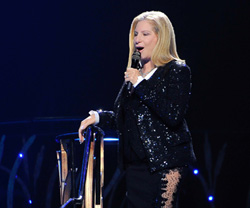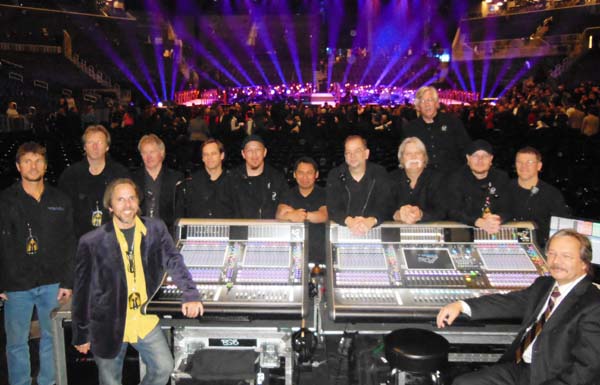
Carlton brought in Steve Colby, the longtime front of house engineer for the Boston Pops and veteran DiGiCo user, to handle the orchestral stem mixes on an SD10. (Earlier this year, Colby added a pair of SD10 consoles to the Pops’ sound system.)
“I’m very, very fond of the platform,” Colby says, “and when we got to the Clair shop the first week for training, I came in at an advantage as I’d had a lot of flight time on the SD10. It was fun to be able to show people some of the things it could do.
“And that’s a credit to the console, too. Everybody latches onto it very quickly. The guys who have been on previous Barbra tours are really, really happy with this new system. They love the fact that we could send signals to and from consoles directly.
“The DiGiCo/Optocore system is a brilliant concept, and sonically it’s extraordinary. The SD10 is a very flexible console. You can drill down pretty deep in terms of surgical equalization and things like that.
“One of the real treats for me was the addition of the DigiTube Tube Emulation on the SD10, which was added with the most recent software upgrade (5.3.2, available for all DiGiCo consoles). So if you’re a guy like me who deals with strings a lot, it’s great to have something overall to warm up the signal. You have the clarity and the noise floor of the digital signal, coupled with the warm analog fuzziness of the DigiTubes. It’s a terrific combination for us.
“This is a particularly large input show,” Colby continues. “It reminds me a lot of the Star Wars show we did with the Pops because we were at 160 inputs and did the whole thing from FOH. It was a chore. With Barbra, we tried to spread the labor around in specialized areas. We’re taking all of the microphones from the orchestra and breaking them down into submixes that go off to other mixers in the system.
“So Chris at front of house is taking my string stems and mixing with other discrete channels, and I make five stems that are sent off to Ian on monitors for Barbra and to Blake on monitors for the orchestra. We’re basically taking the first wave of huge chunks of inputs and cutting them down into something manageable, making lots of subtle mix changes from song to song that we hope will make a difference out front. I’m thinking about what it’s going to sound like in the room; how I can help Chris by giving him something consistent to work with, bumping up solos and things of that nature, so he doesn’t need to worry about it.
“I listen to that and then I also listen to the other stems at the same time from a monitor standpoint. The matrix capability lets me set up a different listening mix on every song, so it helps me to stay honest to the boys that I’m providing feeds for. Having a really deep snapshot automation that can drill all the way down into the matrix inputs and levels is incredibly powerful. The snapshot recall automation on the console is fabulous, too. I like that you can build your own macros. We’re cranking on these shows every day. We get them set up fast, they sound great, and we’re happy as clams.”
On his first tour with Streisand, Suib—whose previous outings include work with Britney Spears—attends to band monitors on an SD10 rig upstage center under the deck. The console, run primarily in conjunction with an Aviom system, is used to generate submixes that are fed to the string section’s in-ear monitors or to various band members with their own adjustable Aviom rigs. He was impressed by the ability for all of the mix engineers to share stage racks and preamps.
“What that means is that we’ve simplified our whole patching world,” Suib explains, “which is huge as far as the logistics. With this new approach, all of the engineers had to agree on something that we stuck with. Traditionally, most award shows and the like use shared stage racks, but that rarely happens on tours. With the DiGiCo Gain Tracking, we each had our own independence.
“In my 30 years, I’ve never had to consult with anybody on any setting on my console. But on this tour, it’s worked really well, and in the end, was definitely worth it because of the amount of inputs we have. With the DiGiCo Gain Tracking, we were able to set the input gains on the first day, make maybe a couple of tweaks here and there for the different zones, and were able to lock that down.
“Each engineer could change his own Digital Trim to boost or reduce the level on the discrete channel, or, if we wanted to make an over-tone change in the mic preamp, we could adjust the mic pre. With the flexibility of the outputs on the DiGiCo, there’s really no competition. I love the console and in particular, the setup. My setup here is pretty basic, though, and I’m mostly only using all the onboard compressors and they are working out great.”
Ian Newton has handled monitors for both Streisand and her special guests since 2006. Newton’s logged time on an SD7 previously with Roger Waters. For Streisand, he’s feeding a stereo pair mix to 40 wedges around the stage.
“As she walks around the stage, I send a mix that I flare through the wedge wherever she is, so we don’t have them blowing into her orchestra mics,” he says. “She gets a balanced mix of everything and everyone uses the wedges with the exception of Il Volo, who are all on in-ears. I’m taking stems from the orchestra from Steve, which helps out and cuts down a bit of mixing on my end.
“Because I’m sending the same mix to all the wedges, I’m using the Copy to Mix feature in the SD7 pretty heavily on the outputs. I’m also using the onboard reverbs, but other than that, I’m not doing anything groundbreaking here. My main challenge is keeping an eye on Barbra all night.”
With strong reviews coming in, the consensus is that Streisand remains at the top of her game at age 70.
“This is really a classic example of having all of the elements in place for a great show,” Weibel sums up. “We have a band that plays great material, are very skilled and generate really good sounds. Chris is a very talented engineer and works really hard, putting in a tremendous amount of time and effort to make sure the overall sound, SPL levels and frequency response is great in every seat…
“Combine that with very capable digital consoles and speaker system, and you have the potential to have really great shows. We’re fortunate in that we have all of those elements in place and working on all eight cylinders. In my personal opinion, we’ve had some really outstanding shows over the course of this tour and have gotten quite a few compliments from people we respect along the way. The new stage racks, particularly, have been really solid and reliable, as have the consoles.
“We’ve literally had no service issues. The rig sounds good; there’s no getting around that. Personally, I’m very satisfied and really pleased.”
“The amount of things that Bruce Jackson shared with us over the years is staggering,” adds Carlton. “One of the highlights of my career was working with him; it was a pleasure. Carrying on his legacy with Streisand, we’re trying to keep pushing that as much as we can. One of the most important things I learned from him was about thoroughness: nailing down every detail you possibly can to make it right, no matter what. And I believe we are doing just that with the Streisand tour. I think we’d make Bruce proud.”


_Mattlarson.jpg)
_MattLarson_Snapshots.jpg)
